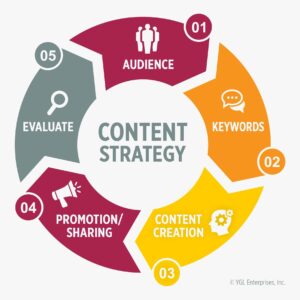Content Strategy: It’s all about creating content that helps people solve problems, find answers, learn, and grow. This includes everything from blog posts to videos to ebooks to infographics to social media posts. Content should help customers understand how your product works, why it matters, and how it can benefit them.
The importance of content and its role in building your brand is not a new concept—content marketing has been around for years, and if anything, the rate of content creation has increased dramatically. Unfortunately, too many brands produce content without first developing a strategy—and only to realize their content efforts are lackluster and ineffective.
So, everyone talks about having a content strategy, but what does that mean when put into practice?
In this post, the content marketing experts at YGL Enterprises, Inc. will examine the essential elements of content strategy, best practices, and common mistakes.
Content Goes Beyond Social Media
It may be tempting to think that “content” only goes as far as your next status update on Facebook, Instagram, or Twitter. However, don’t be tempted by “quick and easy.” As a business owner, you must think beyond social media as the only way to promote your business, engage with your customers, and provide relevant content.
Content touches everything—your website, landing pages, infographics, sales sheets, brochures, newsletters, job descriptions, advertisements, social media… the list goes on. Unfortunately, many small businesses fail to realize that your content should have a home—a permanent one—a space that you own and manage.
We are referencing, of course, your company’s website.
Your website should serve as the hub—the operational center—of your content strategy, and you should not be dependent on your company’s brand image living on a third-party site, for instance, Facebook.
Why?
All that we need to do is point to the recent Facebook and Instagram outage to find cases where small businesses were suddenly offline and unable to promote their business and sell their products or services. So, when Facebook and Instagram crashed for several hours, small businesses without a website lost considerable revenue to the outage as they relied on “rented space” versus owning their marketing message.
Content and the Integrated Experience
As noted above, businesses that offer only one or two options for customer engagement may find themselves at the mercy of a marketing landlord. Instead, think about providing content as an integrated experience. Your content strategy should offer a multi-channel approach, one that includes marketing, selling, educating, and serving your customer base. Just as you search for and consume information on numerous platforms, so does everyone else. Consistent messaging and quality content build trust, credibility, and brand loyalty.
Common Content Mistakes Made by Businesses
As with any activity, rushing to complete a task without understanding the hows and whys will always produce a sub-standard result. Creating content is no exception. Every piece of business-related content should be well-organized and purposeful. Therefore, don’t fall into the trap of producing content for the sake of content or drafting your next blog post on the fly in between client appointments. This is an ineffective approach at best.
Consider these common errors:
- Writing and publishing content for the sake of publishing. As we noted, content must have a purpose and a direction. What is your intent? Will the reader care about the information? Am I providing value? If not, then you’re wasting your time.
- Ignoring the importance of SEO. We have written on this topic multiple times. Your content should be friendly to the search engines and appeal to their algorithms. If you do not have in-house SEO expertise, partner with an SEO specialist who can offer guidance. It is not enough to write content for human beings; you must also appeal to the Google Gods.
- Brainstorming content ideas without supporting data. Review your analytics. Is there a particular piece of content that receives a lot of views and comments? What topics are trending? Can you tie your content idea to a recent event? The bottom line is don’t assume and use your resources. Google Trends is one example of a free online tool that provides insights into consumer behavior and competitive keyword search.
- Not defining your target audience. If you can’t define your buyer’s persona… who your fans are… who are actively searching for the services you provide, then you cannot create a compelling marketing message. You must know the needs, desires, and pain points of your target audience(s) before you draft your content. Otherwise, it’s a waste of time and effort.
- Inconsistent posting. We have seen many companies suddenly focus on intense content creation, only to find this activity wanes when they get busy with client work or something else grabs their attention. For a content strategy to be effective, it cannot be sporadic. Commit to a regular publishing schedule.
- Inconsistent voice due to a lack of brand guidelines. We are big advocates of clearly defined brand guidelines. These guidelines affect messaging, imagery, tone, etc., for use internally and externally. The task of content creation is no exception.
- Not reviewing content performance. Finally, a common mistake is failing to monitor analytics. Google, Facebook, and LinkedIn all offer analytics about user engagement. Evaluation and re-tooling are part of every content strategy. Don’t overlook this critical step.
Formulating a Content Strategy That Gets the Job Done
 Smart brands take a comprehensive approach to content strategy and recognize there are many moving pieces. Realize your approach to content strategy should not be “set it and forget it.”
Smart brands take a comprehensive approach to content strategy and recognize there are many moving pieces. Realize your approach to content strategy should not be “set it and forget it.”
Therefore, when creating a content strategy, remain mindful of the following points:
- Your audience. Take the time to develop buyer personas. Identify your target audience and how their needs and interests link back to your acquisition and retention goals.
- Keywords and phrases. Understand the basics of online search. The search query can be as simple as “accountant in Charlotte” or as detailed as “How much does a CPA in Charlotte charge for tax returns?”
- Content creation is a multi-step process. It requires audience identification, brainstorming, research, selection of promotional channels, monitoring, and data analysis. All actions to get as many eyeballs on your content as possible.
- Repurposing content. You should be able to get some proverbial “miles” out of the content you produce. For more guidance on that topic, click here.
- Business visibility. At the end of the day, the goal is to grow your business’s followers and boost engagement—and this cannot be accomplished simply by random posting via one channel. Instead, ensure that your content strategy is comprehensive and addresses multiple media and approaches to promotion.
YGL Enterprises Helps Professional Services Firms Develop Content Strategy
Knowing where to begin developing a content strategy might feel a bit overwhelming. However, the good news is you do not have to go it alone. The marketing experts at YGL Enterprises are well-versed in consulting with B2B companies and serving as a strategic partner in architecting content strategies that will enable you to reach your goals and objectives.
We welcome the opportunity to speak with you about your content strategy and its place in a comprehensive marketing plan and campaign. Reach out and schedule a consultation today.
 Yvonne Levine, president of YGL Enterprises, Inc., is a strategic marketing consultant who collaborates with professional services and small and mid-sized businesses to develop and execute successful marketing strategies, branding initiatives, content creation, and digital marketing plans. By helping businesses devise a targeted strategy first, this approach creates a strong foundation for tactical decisions, which drives brand awareness and positive results. Follow Yvonne on LinkedIn and Facebook.
Yvonne Levine, president of YGL Enterprises, Inc., is a strategic marketing consultant who collaborates with professional services and small and mid-sized businesses to develop and execute successful marketing strategies, branding initiatives, content creation, and digital marketing plans. By helping businesses devise a targeted strategy first, this approach creates a strong foundation for tactical decisions, which drives brand awareness and positive results. Follow Yvonne on LinkedIn and Facebook.

